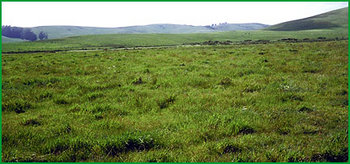Coastal Hills - Santa Rosa Plain
This subsection consists of a broad northwest-southeast aligned valley in which the Santa Rosa Plain is located, and the rolling hills between the Pacific Ocean and the Santa Rosa Plain. The description of subsection 263Ak is applicable to Bodega Head and the sand spit that is southwest of the San Andreas Fault. The climate is temperate to hot and humid, with marine air advancing over the hills most of the time. MLRAs 14c and 15c.
Contents
Lithology and Stratigraphy
This subsection contains predominantly Pliocene and Quaternary marine and nonmarine sediments and recent alluvium in inland valleys and on the Santa Rosa Plain; and upper Pliocene marine sediments on the hills between the Santa Rosa Plain and the Pacific Ocean. Franciscan rocks of the Central and Coastal Belts are minor components in this subsection.
Geomorphology
This subsection contains moderately steep hills on upper Pliocene sediments that have been faulted and eroded to expose rocks of the Franciscan Complex, Quaternary nonmarine terraces, and floodplains. The elevation range is from sea-level up to about 900 feet. Fluvial erosion is the main geomorphic process on the coastal plain and nonmarine terraces. Fluvial erosion and deposition are active on the alluvial plains.
Soils
The soils on the rolling hills are mostly Ultic Haplustalfs. On upper Pliocene sediments of the Santa Rosa Plain they are Haploxerults, Pelloxererts, and Palexeralfs. On Quaternary terraces they are Durixeralfs, Albaqualfs, and Haploxeralfs. And on recent alluvium they are Fluvaquentic Haploxerolls and Pelloxererts. The soil temperature regimes are mesic and thermic inland, mesic on the rolling hills between the Santa Rosa plain and the Pacific Ocean, and isomesic along the coast. Soil moisture regimes are xeric (nearly ustic) and aquic on the Santa Rosa Plain and vicinity, and ustic, and possibly some udic, on the rolling hills west of the Santa Rosa plain and along the coast.
Vegetation
The predominant natural plant communities are Needlegrass grasslands and Valley oak series in the inland valleys. Northern claypan vernal pools occur on the Santa Rosa Plain, and Pacific reedgrass series and Needlegrass grasslands occur on the rolling hills westward to the coast. Coast live oak series is common on some leeward slopes in the rolling hills.
Characteristic series by lifeform include:
- Dune vegetation: European beachgrass series, Sand - verbena - beach bursage series.
- Saltmarsh vegetation: Pickleweed series, Saltgrass series.
- Grasslands: California annual grassland series, Foothill needlegrass series, Introduced perennial grassland series, Pacific reedgrass series, Purple needlegrass series.
- Vernal pools: Northern claypan vernal pools.
- Shrublands: Dune lupine - goldenbush series.
- Forests and woodlands: Coast live oak series, Oregon white oak series, Red alder series, Valley oak series.
Climate
The mean annual precipitation is about 20 to 40 inches; there is summer fog. Mean annual temperature is about 50° to 58°F. The mean freeze-free period is about 225 to 300 days. Surface
Water
Water runs off to streams and alluvial plains moderately rapidly, but it accumulates in slight depressions on alluvial plains. The ephemerally flooded depressions are called vernal pools.
Return to Northern California Coast
